VOLKSWAGEN GOLF MK6 2012 Owners Manual
Manufacturer: VOLKSWAGEN, Model Year: 2012, Model line: GOLF MK6, Model: VOLKSWAGEN GOLF MK6 2012Pages: 516, PDF Size: 105.12 MB
Page 161 of 516
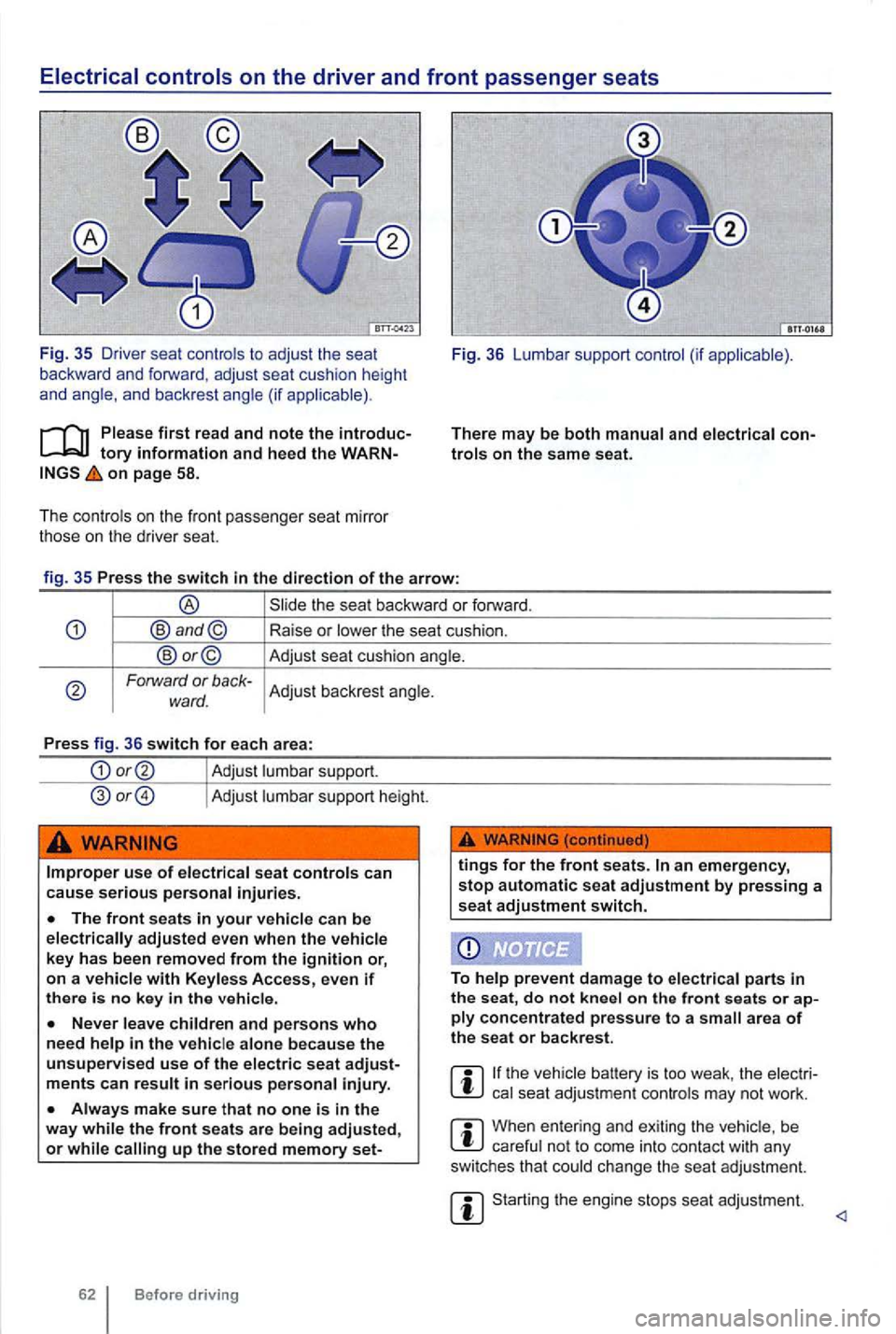
on page 58.
The cont rols on the front passenger seat mirro r
those on the driver seat. Fig
. 36 Lumbar support control (if app licable) .
There
may be both manual and elect rical
Forward or back-Adjust backrest angle. ward.
Press fig. 36 switch for each area:
Adjust lumbar support.
Adjust lumbar support height.
Improper use of electrical seat controls can cause serious personal injuries.
up the stored memory set-
tings for the front seats.
on ply concentrated pressure to a area of the seat or backrest.
the vehicle battery is too weak , the elect rical seat adjustment controls may not work .
When entering and exiting the vehicle , be careful not to come into contact with any
switches that could change the seat adjustment.
Starting the engine stops seat adjustment.
Page 162 of 516
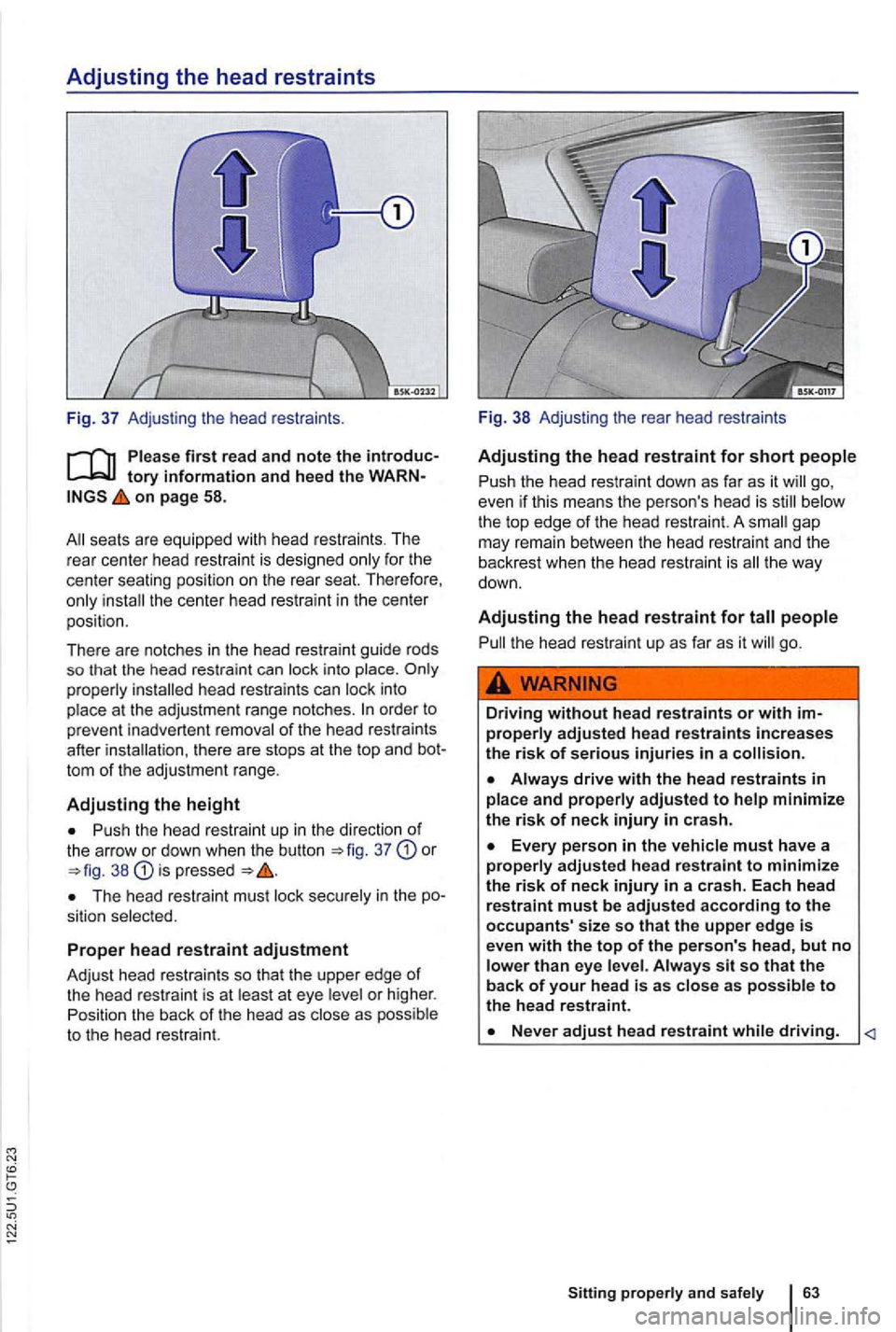
Adjusting the head restraints
Fig. 37 Adjusting the head restraints .
on page 58.
th e ce nter head rest rai nt in th e center
pos ition.
There are notches in the head restraint gu ide rods
so that the head restraint can lock into place .
prope rly
tom of the adjus tment range.
Adjusting the height
37 o r 38 is
The head restraint must lock secu re ly in the
gap
may rema in betwee n th e head restra int and th e
ba ckrest when the head rest r
aint is t h e way
down .
Adjusting the head restraint for
go.
Dri v
ing without head restraints or with properly adjusted head restraints increases
the risk of serious injuri es in a collision.
Page 163 of 516
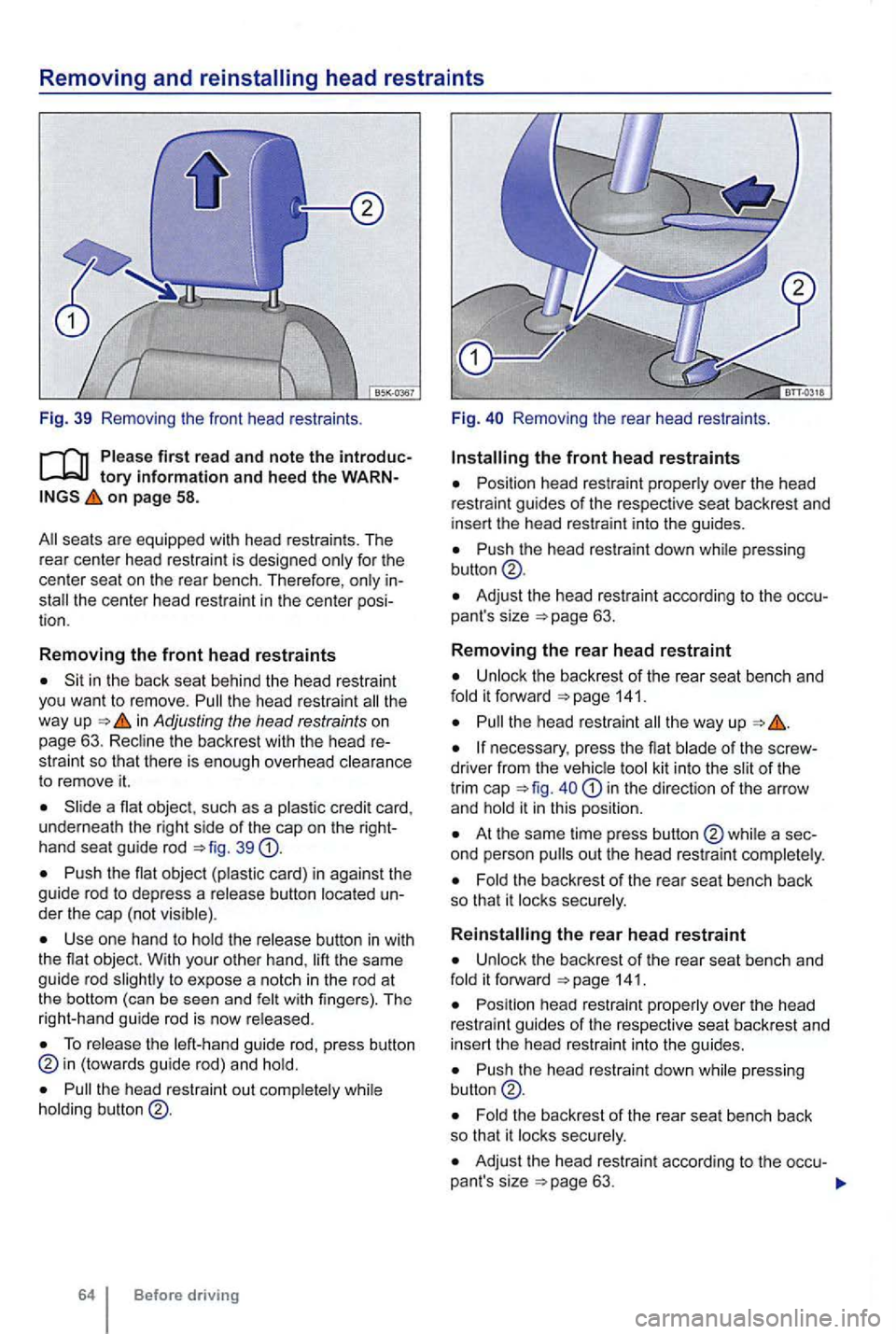
Removing and reinstalling head restra ints
Fig. 39 Remo ving the front head restraints .
on page 58.
for the
center seat on the rear bench . T he refore ,
Sit in the back seat behind the head restraint
you want to remove. the head restraint th e
way up in Adjusting the head restraints on
page 63. the backrest with the head re
stra int so that there is enough overhead
to remove it.
a nat object , such as a
button
Use one hand to the same
guide rod to expose a notc h in the rod at
t he bottom (can be seen and with fingers) . T he
r ight-hand guide rod is now
To the guide rod, p ress button (towards guide rod) and
the head restraint out
64 Before driving F
ig.
Removing the rear head restr aints .
Posi tion head restraint over the head
restr aint guides of the respective seat backrest and
i nsert the head restra int into the guides.
Push the head restraint down
Adjust the head rest raint according to the occu
pant's size 63.
Removing the rear head restraint
the backrest of the rear seat bench and it forward 141.
the head restrain t
necessary , press the nat of the scr ew
d river from the kit in to the of the
tr im cap in the direction of the arrow
and
At the same time press button
the back rest of the rea r seat bench back
so that it
it forward 141.
P osition head restraint over the head
restraint guides of the respective seat backrest and
i ns e
rt the head restrain t into the guides.
Push the head restraint down pressing
t he backres t of the rear seat bench back so that it
Adjust the head restraint according to the occu-
pant 's size
Page 164 of 516
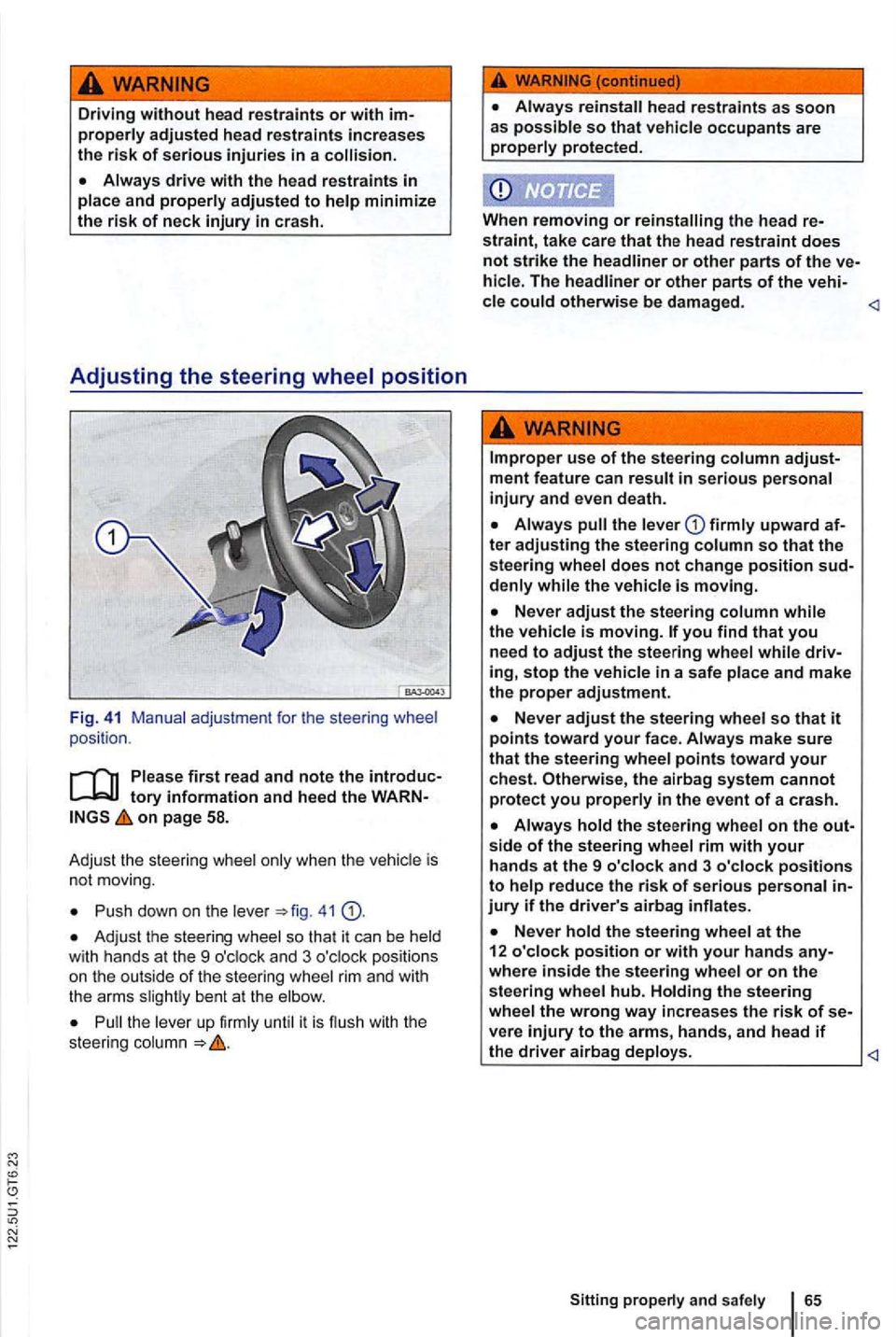
Driving without head restraints or with properly adjusted head restraints increases
the risk of serious injuries in a
tory information and heed the on page 58.
Adju st the steerin g whee l only w he n the veh icl e is
no t m ovi ng.
Push dow n o n the leve r 41
Adj ust th e steering whee l so th a t it ca n b e held w ith hands at the 9 o'cloc k and 3 o 'clock positio ns
o n the out side of the steering wheel rim and with
t he arms slightl y b ent at the elbow .
Pull the leve r up firml y until it is flu sh with th e
stee ring colum n
the lever
denly while the vehicle is moving.
Never adjust the steering wheel so that it points toward your face . Always make sure that the steering wheel points toward your chest. Otherwise, the airbag system cannot protect you properly in the event of a crash.
side of the steering wheel rim with your hands at the 9 o'clock and 3 o'clock positions to help reduce the risk of serious personal
where inside the steering wheel or on the steering wheel hub. Holding the steering wheel the wrong way increases the risk of vere injury to the arms, hands, and head if the driver airbag deploys.
Page 165 of 516
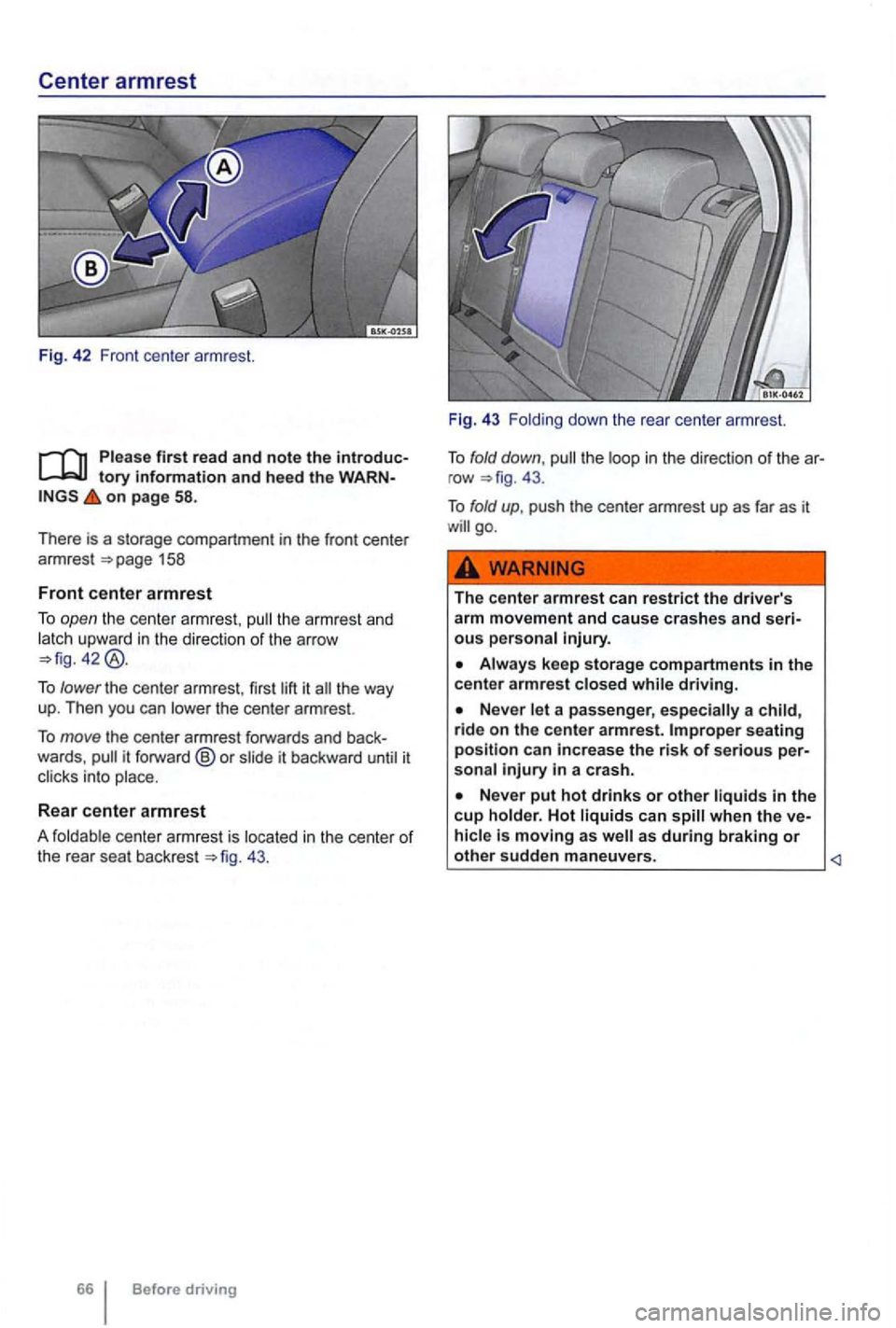
Center armrest
Fig . 42 Front center arm rest.
on page 58.
There is a storage compartment in the front center
armrest
the armr est an d
latch upward in the direction of the arrow
To lower the center arm rest , firs t lift it the way
up . T hen you can lower the cente r armrest.
T o
move the center armrest forwards and back
wards ,
43.
66
the loop in the direction of the ar
r ow 4 3.
To fold up, push the center armrest up as far as it go .
The center armrest can
restrict the driver's
arm movement and cause crashes and seri-
ous personal injury.
Page 166 of 516
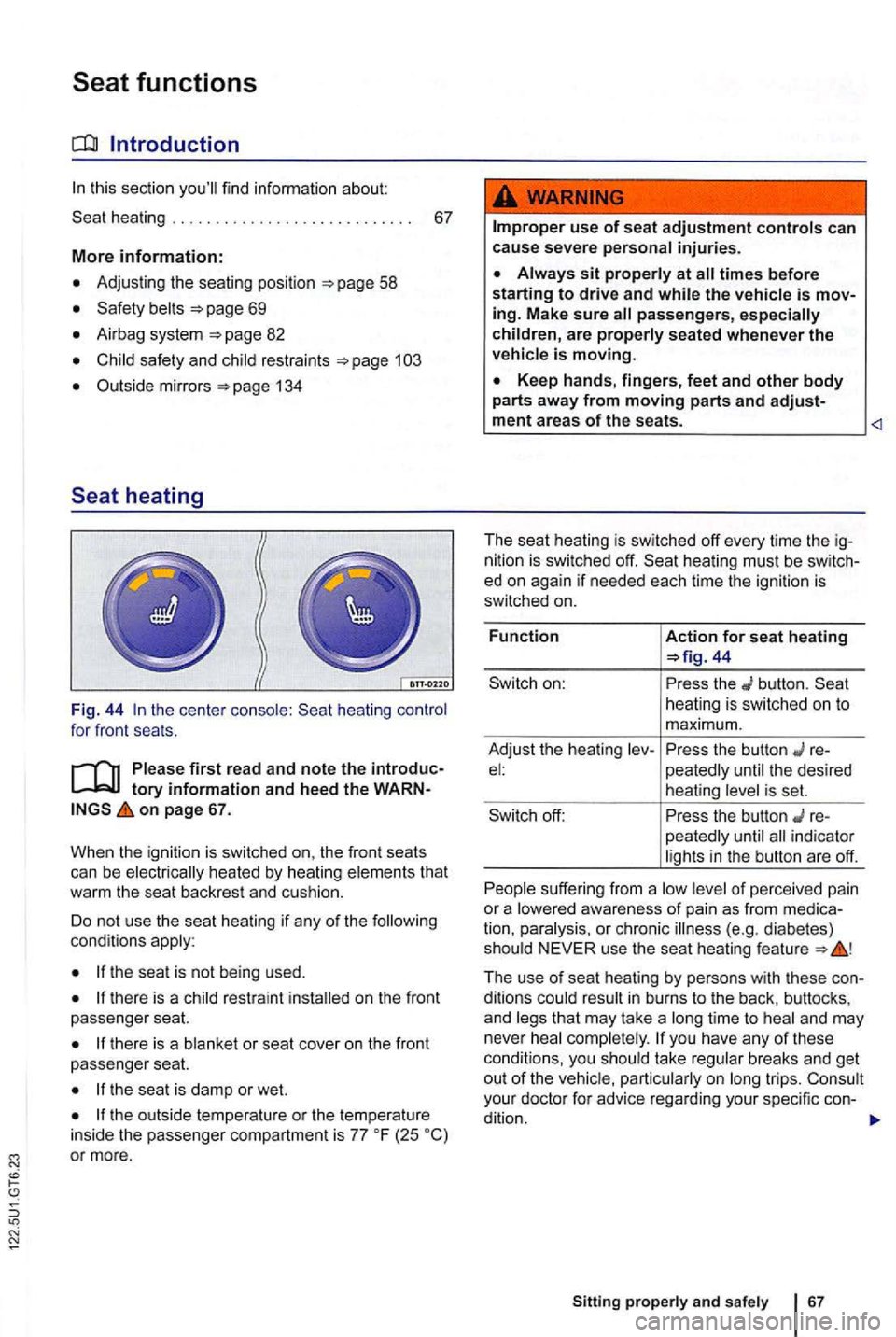
this section find information about:
. . . 67
More information:
Adjusting the seating position 58
69
Airbag system page 82
safety and restraints
Outside mirrors 134
the cente r heating for front seats.
on page 67.
When the igni
tion is sw itched on, the front seats
can be that
wa rm the seat backrest and cush ion .
Do not use the seat heating
if any of the cond itions
the sea t is not being used.
on the front
passenger seat.
there is a or seat cover on the front
passenger seat.
the seat is damp or wet.
(25 or more .
use of seat adjustment controls can
cause severe personal injuries.
passengers, especially
children, are properly seated whenever the
44
button. heating is sw itched on to
m aximum.
Adjust the hea ting
re-the desired
heating
the button re
peatedly indicator
s uff ering from a of perce ived pain
or a
The use of seat heating by persons with these conditions time to and may
never
take breaks and get out of the trips. your docto r fo r advice rega rding your specific con-
dition.
Sitting a nd 67
Page 167 of 516
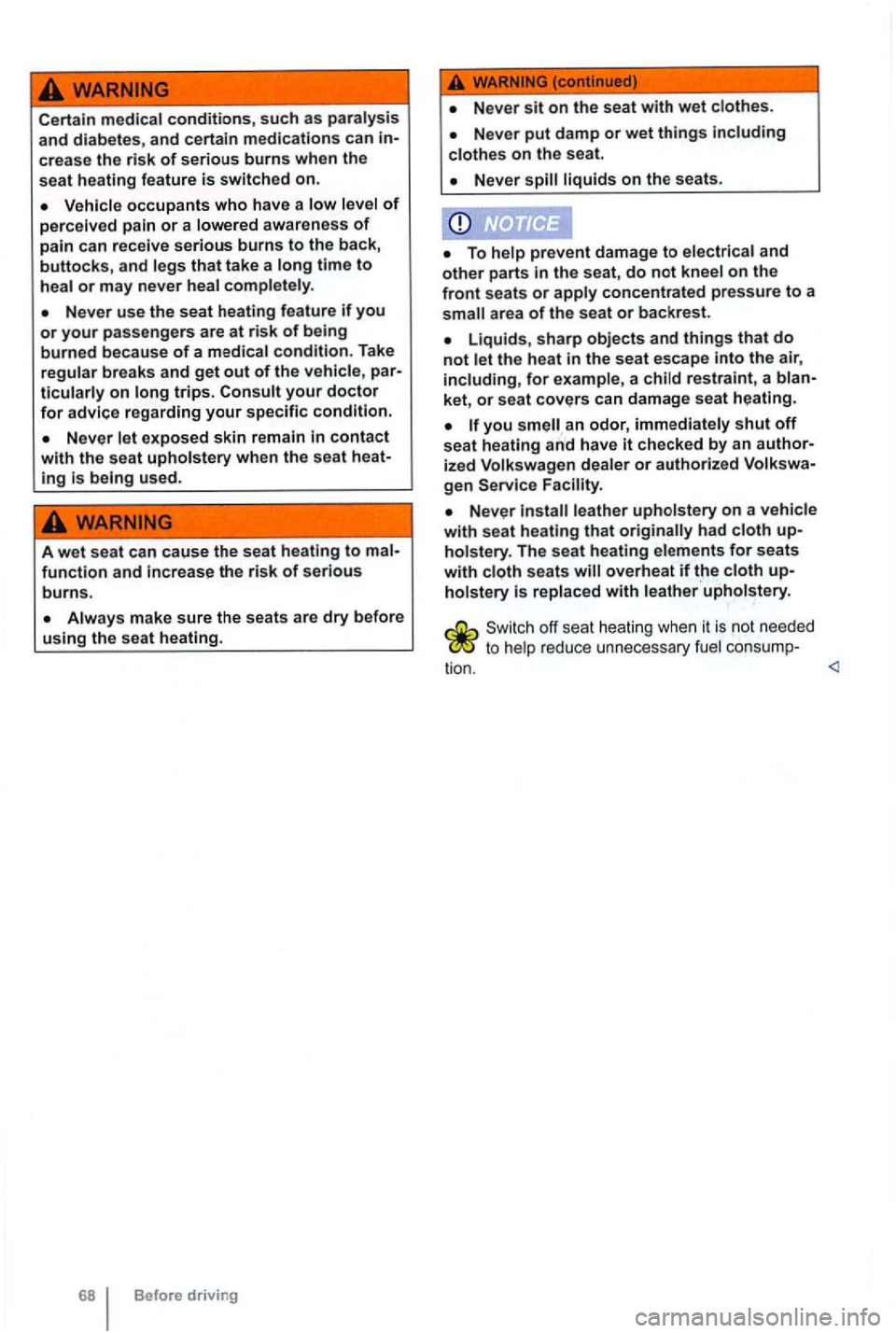
Certain and diabetes, and certain medications can in-
crease the risk of serious burns when the seat heating feature is switched on.
occupants who have a of perceived pain or a awareness of pain can receive serious burns to the back, buttocks, and time to
Never use the seat heating feature
condition. Take par-on your doctor for advice regarding your specific condition.
Never when the seat heat-ing is being used.
A wet seat can cause the seat heating to function and the risk of serious burns.
make sure the seats are dry before using the seat heating.
68 Before driving
Never sit on th e seat with wet
Never
To on the front seats or
Liquids, sharp objects and things that do not for a ket, or seat covers can damage seat heating.
you an odor, shut off sea t heating and have it checked by an authorized or authorized gen Service
on a
The seat heating
Switch off se a t heat in g when it i s not needed reduce unne ce ss ary co nsum p-
t io n.
Page 168 of 516
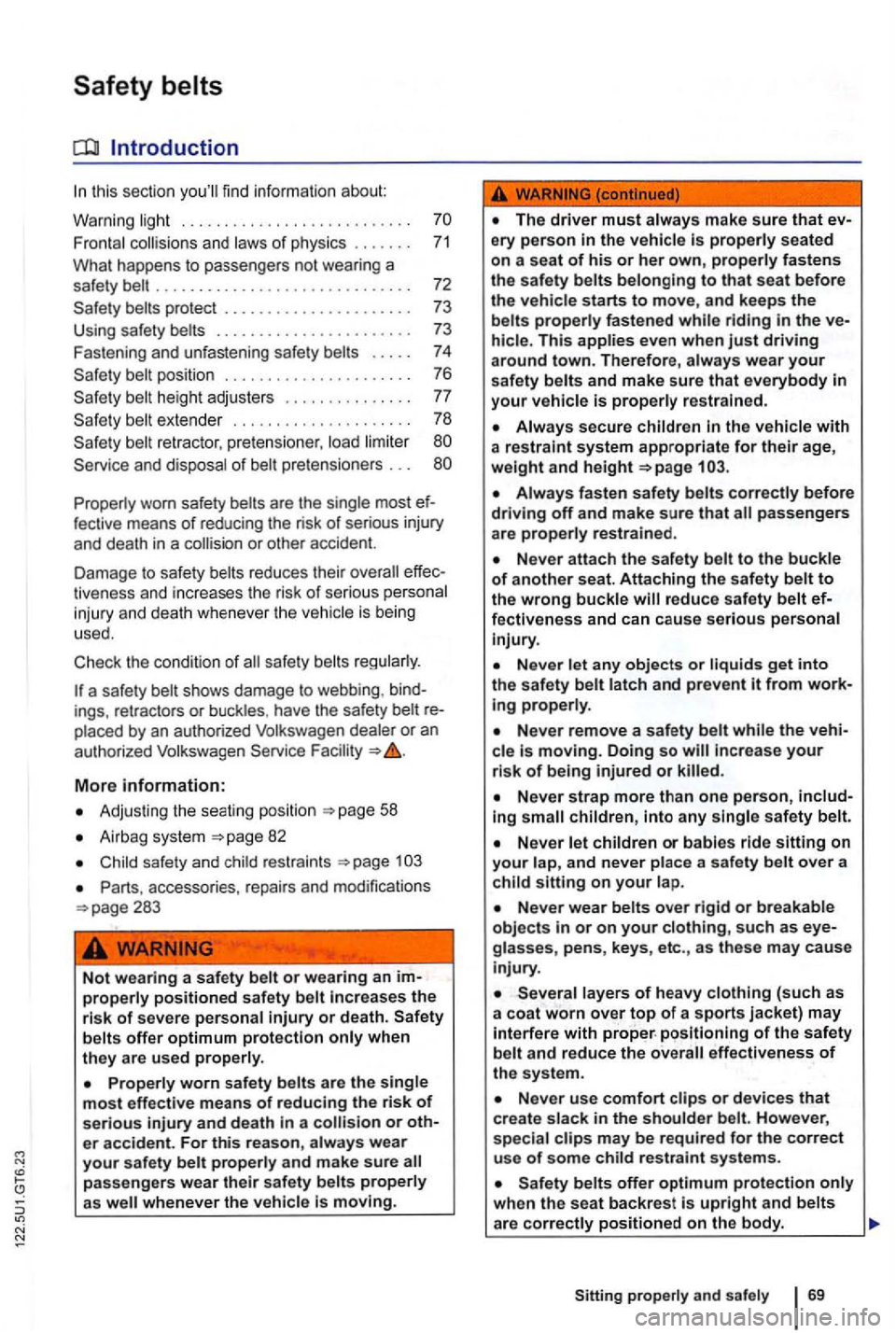
find informati on about:
Fro nt al
Properly worn safety fective means of reducing the risk of serious injury
and death in a or othe r accident.
D amage to sa fety belts reduces their
tiveness and increases the risk of se rious personal
i nj ury and death whenever the vehicle is being
used .
Check the conditi on of
a safe ty belt shows damage to webbing , ings, retracto rs or buckles . have the safety belt
More information:
Adjusting the seating posit io n
Airbag system
Child safety and child restraints 103
Parts , access ories, repai rs and modifications
Properly worn safety belts are the single most effective means of r educing the risk of serious injury and death in a collision or er accident. For this reason , always wear your safety belt properly and make sure all
pa ssengers wear their safety belts properly as well whenever the vehicle
The driver must always make sure that
hicle. Thi s applies even when just driving around town. Therefore, always wear your safety belts and make sure that everybody in your vehicle is properly restrained.
Always secure children
Always fasten safety belts correctly before driving off and make sure that all passengers
are properly re strained .
Never attach the safety belt to the buckle of another seat. Attaching the safety belt to the wrong buckle will reduce safety belt fectiveness and can cause serious personal injury.
cle is moving. Doing so will
small children, into any single safety belt.
Never wear belts over rigid or breakable objects in or on your clothing, such as glasses, pens, keys, etc., as these may cause injury.
layers of heavy clothing (such as
a coat worn over top of a sports jacket) may with proper. positioning of the safety belt and reduce the overall effectiveness of the system .
Never use comfort clips or devices that create slack in the shoulder belt. However,
s pecial clips may be required for the correc t
u se of some child res traint systems.
Page 169 of 516
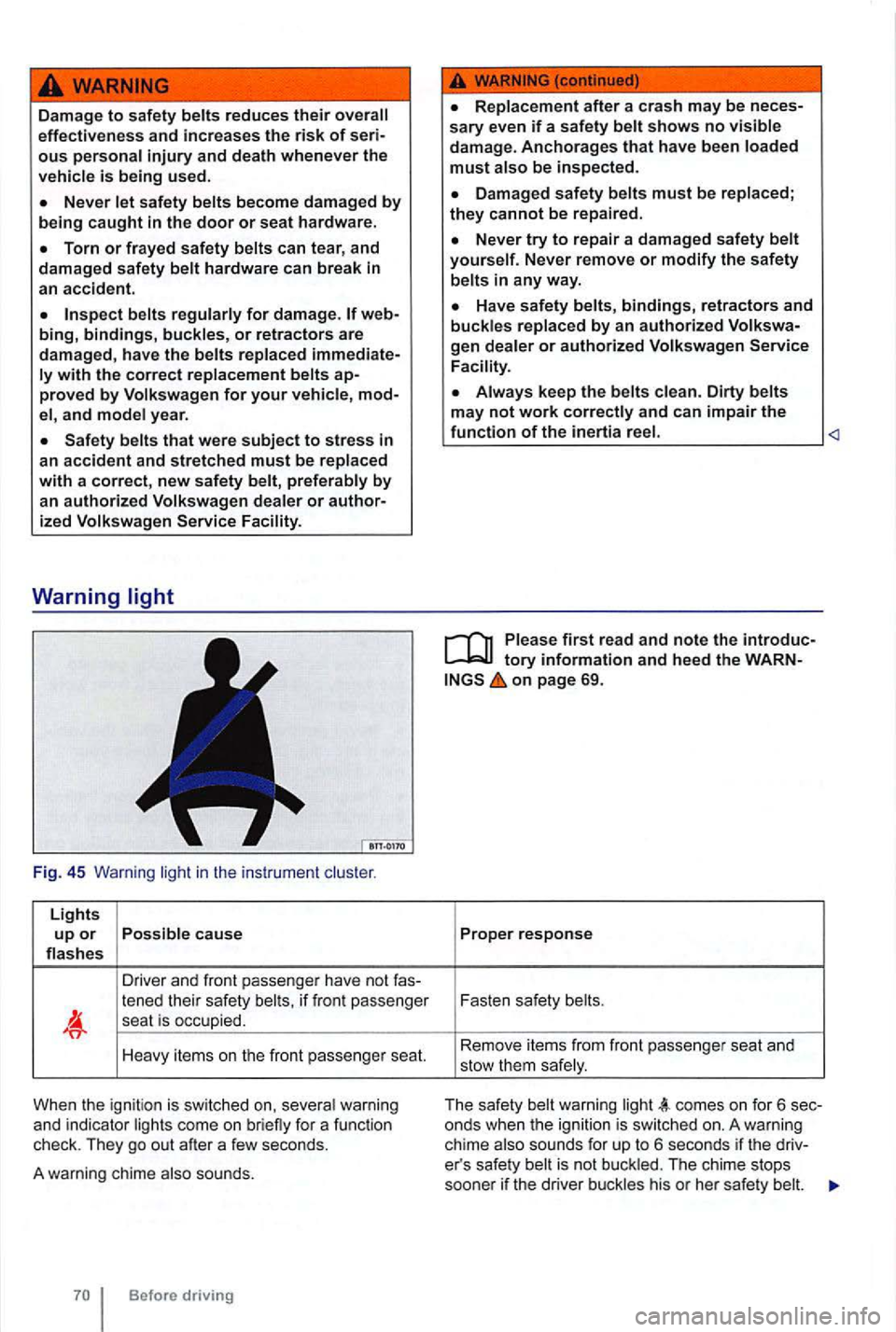
Damage to safety belts re duces their effective ne ss and increa ses the risk of serious personal injury and death whenever the
v ehicle is being used.
Torn or frayed safety belts can te ar, and
damag ed safety belt hardware can break
web
bing, bindings, buc kles, or retractors are damaged , hav e the belts replaced immediate
ly with the correct replacement belts proved by Volkswagen for your vehicle, model , and model yea r.
Fig . 45 Warning light in the instrume nt
Lights up or Possible caus e flas hes
Driver and front p asse nge r have not
tened their safety belts, if fr o nt passenger sea t is occup ied.
Heavy items on the front passe nge r seat.
Whe n the ign itio n is switched on, seve ra l warni ng
and indica tor lights come on brie fly for a func tion
check. They go out after a few seconds.
A warning chime also sounds.
Replacement after a crash may be neces
s ary even if a sa fety belt shows no visible damag e. Anchorages that have been loaded must also be inspect ed .
D amaged safety belts must be replaced ; they cannot be repaired .
Never try to repair a dam ag ed s afety belt yourself. Never remove or modify the safety
belts in any way.
Have safety belts, bindings, retractors and buckles replaced by an authorized
Always keep the belts clean . Dirty belts
may not work
tory information and heed the WARNon page 69.
Proper response
Fasten safety belts .
Re move it e m s f
rom fr ont passe nger seat and
stow them safe ly .
T
he safety belt wa rnin g light comes on f or 6 sec
onds when the ignition is sw itched on. A warning
ch ime also sounds for up to 6 seco nds if the driver's safe ty belt is not bu ckl ed . Th e c hime stops
soone r if the driver buckles his or her safe ty be lt.
Page 170 of 516
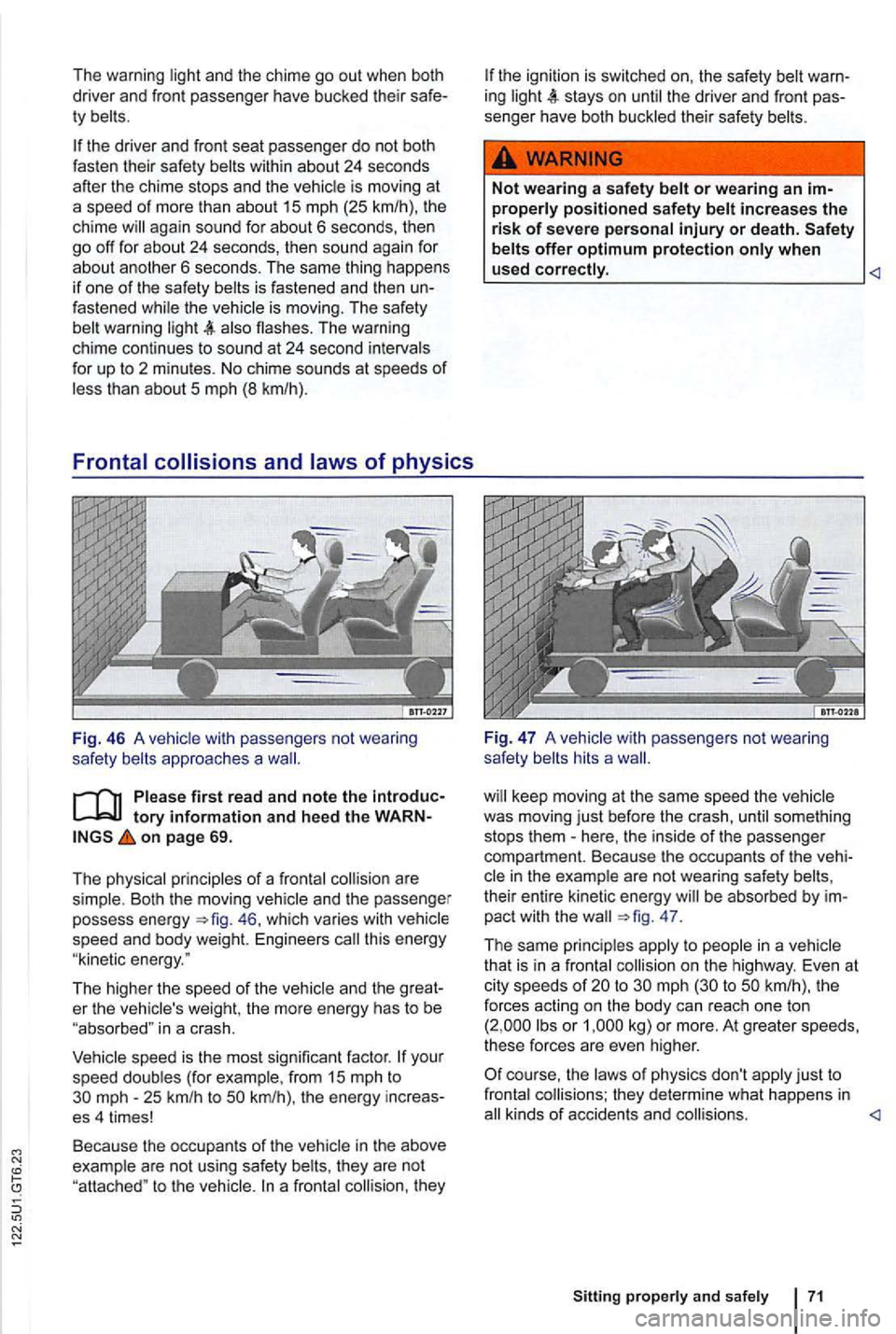
and the chime go out when both
driver and f ront passenger have bucked their ty
again sound for about 6 seconds, then go off for abo ut 24 seconds, then sound aga in for about anolher 6 seconds. The same thing happens
i f one of the safety fastened warning
of physics
Fig. 46 A vehicle with passengers not wearing safety
on page 69.
The physical principles of a frontal are
s imple . Both the moving vehicle and the passenger
possess energy 46, which varies with
er the vehicle 's weight, th e more energy h as to be "abso rbed" in a c rash.
speed is the most significan t factor .
they are not "attached " to the
increases the risk of severe personal injury or death.
with passengers not wea ring
safety
keep moving at the same speed the ve hicle was moving just befo re the cras h,
in the example are not wearing safety their entire kinetic energy pact with the 47.
The same principles on the highway. Even at
c ity speeds of 20 to 30 mph (30 to 50 km/h), the
fo rces acting on the body can reach one ton
(2 ,000 o r kg) or more. At greater speeds,
these forces are even higher.
of physics don't j ust to frontal they determine what happens in kinds of accidents and